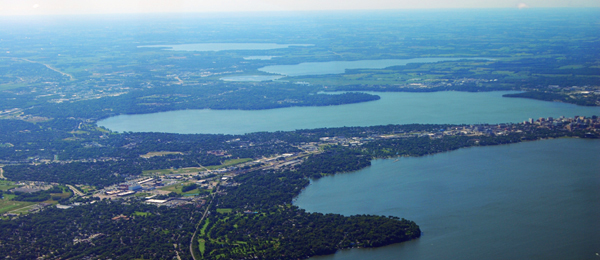Yahara Watershed

In my apartment here in Madison, the water I use comes from a deep sandstone aquifer, which serves most Madison residents. There are twenty-two municipal wells here, pumping ten billion gallons of water per year. I was very surprised to learn that total municipal water usage in Madison has been declining, pretty significantly in recent decades, despite a growing population. This is a wonderful turnaround considering that through the ‘50s to the 90’s, the water table was on a decline. That is to say, we were pumping water too quickly for the aquifer to replenish. The water table hit an all time low in 1998, reaching 130 feet deep. Presently, the water table depth is around 90 feet, akin to pre-1950 levels. According to Madison Water Utility water supply manager Joe DeMorett, the change is largely due to more efficient appliances like dishwashers and toilets, as well as improvements in industry practices which are becoming less water heavy.
So thats where my shower water comes from. Once it's down the drain, it goes to the Yahara Watershed which encompasses our four lakes. The Yahara Watershed is a beast, supporting a dense urban center, many acres of highly productive farmland, and natural areas all at the same time.
Now, life would be very hard without a healthy watershed. If our watershed became too polluted to use, or if we overdrew it to the point that the water was too deep to reach, we would be in deep trouble. Many millions of dollars would be needed to "fix" the problem, either digging deeper wells or treating the poisonous water. If things get really bad we might have to pump water from another watershed, but that is really ecologically infeasible. Really the only way to fix this kind of issue, is to reduce our water use, which thankfully is being done.
If Madison suddenly lost running water, I don't know about you guys, but I wouldn't have a clue about what to do next. I'm sure I'd make it to the store too late to grab a pack of water bottles, so, I think I'd be very thirsty and dirty for the next few days until the government could rush in with all sorts of supplies, meant to save clueless urbanites like me should such a disaster happen. This is all to say that, without good infrastructure and a resilient watershed, most of us would be screwed. Asking my partner sitting next to me what she would do if the water stopped: "I don't know, probably freak out and go to my parents house," I feel assured that I am not the only helpless city-dweller. Thinking about my friends here, I would be surprised if more than a handful knew where their water comes from.

Government response to Toledo 2014 water crisis
Sources:
https://www.cityofmadison.com/water/insidemwu/all-eyes-on-the-aquifer-is-madisons-water-supply-sustainable
https://wsc.limnology.wisc.edu/about/watershed
Los Angeles is also dealing with declining water storage but for different reasons. California has dealt with water loss as long as I have been alive because of droughts! We have to get a lot of our groundwater from the Colorado aqueduct. It's expensive and not super-efficient, but we still have running water lol!
ReplyDeleteI had no idea about the previously declining water table in the previous century. Can't imagine what Madison, both the city and the college, would look like today if not for the innovation that saved it.
ReplyDelete